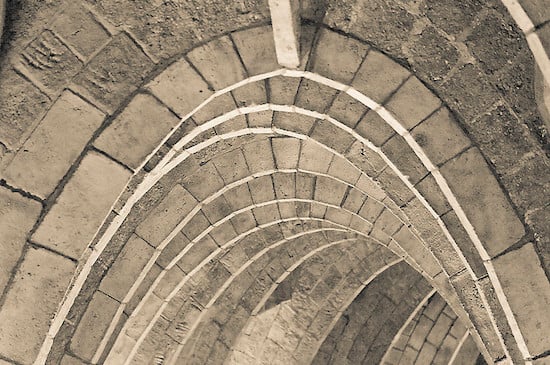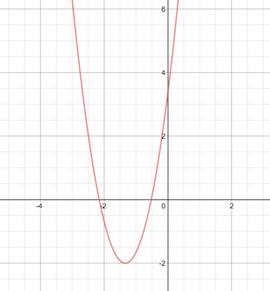How Do You Find The Vertex Of A Quadratic Equation
Once y'all have the quadratic formula and the basics of quadratic equations down cold, information technology'south time for the side by side level of your human relationship with parabolas: learning about their vertex grade. Read on to learn more about the parabola vertex course and how to convert a quadratic equation from standard course to vertex class. feature image credit: SBA73/Flickr The vertex form of an equation is an alternating fashion of writing out the equation of a parabola. Normally, you'll see a quadratic equation written as $ax^two+bx+c$, which, when graphed, will exist a parabola. From this form, it's easy plenty to find the roots of the equation (where the parabola hits the $x$-centrality) by setting the equation equal to null (or using the quadratic formula). If yous need to observe the vertex of a parabola, however, the standard quadratic form is much less helpful. Instead, you'll desire to catechumen your quadratic equation into vertex class. While the standard quadratic course is $ax^2+bx+c=y$, the vertex course of a quadratic equation is $\bi y=\bi a(\bi x-\bi h)^2+ \bi k$. In both forms, $y$ is the $y$-coordinate, $x$ is the $10$-coordinate, and $a$ is the constant that tells you whether the parabola is facing upward ($+a$) or downwardly ($-a$). (I think almost it every bit if the parabola was a basin of absurdity; if there's a $+a$, I can add applesauce to the bowl; if in that location's a $-a$, I tin can milk shake the applesauce out of the bowl.) The difference betwixt a parabola's standard form and vertex form is that the vertex course of the equation also gives you the parabola's vertex: $(h,grand)$. For example, take a look at this fine parabola, $y=iii(x+4/3)^2-ii$: Based on the graph, the parabola'southward vertex looks to be something similar (-1.five,-2), merely it's difficult to tell exactly where the vertex is from merely the graph solitary. Fortunately, based on the equation $y=3(x+4/three)^ii-2$, nosotros know the vertex of this parabola is $(-four/3,-2)$. Why is the vertex $(-4/3,-ii)$ and not $(four/3,-two)$ (other than the graph, which makes information technology clear both the $x$- and $y$-coordinates of the vertex are negative)? Think: in the vertex form equation, $h$ is subtracted and $k$ is added. If you have a negative $h$ or a negative $grand$, you'll demand to brand sure that you lot decrease the negative $h$ and add the negative $k$. In this case, this means: $y=three(x+four/3)^2-2=three(10-(-4/three))^2+(-2)$ and and so the vertex is $(-iv/three,-2)$. Yous should e'er double-check your positive and negative signs when writing out a parabola in vertex course, particularly if the vertex does not have positive $x$ and $y$ values (or for you quadrant-heads out there, if it's not in quadrant I). This is like to the check you'd exercise if you lot were solving the quadratic formula ($x={-b±√{b^2-4ac}}/{2a}$) and needed to make sure yous kept your positive and negatives straight for your $a$s, $b$s, and $c$southward. Below is a tabular array with farther examples of a few other parabola vertex form equations, along with their vertices. Notation in detail the divergence in the $(10-h)^2$ role of the parabola vertex form equation when the $ten$ coordinate of the vertex is negative. Parabola Vertex Form Vertex Coordinates $y=5(10-iv)^2+17$ $(iv,17)$ $y=ii/3(x-8)^ii-ane/3$ $(8,-1/iii)$ $y=144(x+1/2)^2-2$ $(-i/2,-2)$ $y=1.8(10+2.4)^two+2.four$ $(-2.4,2.4)$ Virtually of the time when yous're asked to convert quadratic equations between different forms, you'll exist going from standard form ($ax^2+bx+c$) to vertex class ($a(10-h)^two+grand$). The process of converting your equation from standard quadratic to vertex class involves doing a fix of steps called completing the square. (For more about completing the square, exist sure to read this article.) Let's walk through an instance of converting an equation from standard form to vertex form. We'll first with the equation $y=7x^2+42x-3/xiv$. The get-go thing y'all'll want to practise is move the constant, or the term without an $x$ or $x^2$ next to it. In this instance, our constant is $-3/14$. (Nosotros know it'due south negative $3/fourteen$ because the standard quadratic equation is $ax^2+bx+c$, not $ax^2+bx-c$.) First, we'll take that $-iii/fourteen$ and move information technology over to the left side of the equation: $y+3/14=7x^2+42x$ The next step is to cistron out the seven (the $a$ value in the equation) from the right side, similar so: $y+iii/14=vii(x^2+6x)$ Great! This equation is looking much more like vertex form, $y=a(x-h)^2+k$. At this signal, yous might be thinking, "All I demand to practise at present is to move the $iii/fourteen$ back over to the right side of the equation, right?" Alas, non and then fast. If you take a look at part of the equation inside of the parentheses, you'll notice a trouble: it'due south not in the class of $(x-h)^two$. There are too many $x$due south! So nosotros're not quite done even so. What nosotros need to practise at present is the hardest office—completing the square. Let's take a closer look at the $x^2+6x$ office of the equation. In gild to factor $(x^two+6x)$ into something resembling $(x-h)^2$, we're going to need to add a constant to the within of the parentheses—and we're going to need to remember to add that constant to the other side of the equation likewise (since the equation needs to stay balanced). To set this up (and make certain nosotros don't forget to add the abiding to the other side of the equation), we're going to create a bare space where the constant will go on either side of the equation: $y+three/xiv+7($ $)=7(x^two+6x+$ $)$ Note that on the left side of equation, we fabricated sure to include our $a$ value, 7, in front of the space where our constant will go; this is because we're not just adding the constant to the right side of the equation, but we're multiplying the constant by whatever is on the exterior of the parentheses. (If your $a$ value is ane, you don't demand to worry about this.) The next step is to complete the square. In this case, the square you lot're completing is the equation inside of the parentheses—by adding a constant, you're turning it into an equation that can exist written equally a square. To summate that new constant, take the value next to $10$ (6, in this case), carve up it by 2, and square information technology. $(6/two)^2=(3)^2=nine$. The constant is 9. The reason we halve the half dozen and square it is that we know that in an equation in the form $(x+p)(x+p)$ (which is what we're trying to get to), $px+px=6x$, then $p=6/two$; to get the abiding $p^2$, nosotros thus have to take $6/2$ (our $p$) and square it. Now, replace the blank space on either side of our equation with the constant nine: $y+iii/14+seven(9)=7(x^2+6x+ix)$ $y+{3/xiv}+63=seven(x^2+6x+9)$ $y+{3/14}+{882/14}=7(x^2+6x+9)$ $y+{885/14}=7(10^2+6x+9)$ Next, factor the equation inside of the parentheses. Because we completed the square, yous will exist able to factor it as $(10+{\some \number})^2$. $y+{885/fourteen}=7(10+3)^2$ Last pace: move the non-$y$ value from the left side of the equation back over to the right side: $y=vii(x+3)^2-{885/xiv}$ Congratulations! Y'all've successfully converted your equation from standard quadratic to vertex form. Now, most bug won't just inquire you lot to convert your equations from standard form to vertex form; they'll want you lot to actually give the coordinates of the vertex of the parabola. To avoid getting tricked by sign changes, allow'southward write out the full general vertex form equation directly to a higher place the vertex class equation we just calculated: $y=a(x-h)^two+1000$ $y=7(ten+3)^2-{885/14}$ So nosotros tin can easily notice $h$ and $k$: $-h=3$ $h=-3$ $+k=-{885/14}$ The vertex of this parabola is at coordinates $(-iii,-{885/14})$. Whew, that was a lot of shuffling numbers around! Fortunately, converting equations in the other direction (from vertex to standard form) is a lot simpler. Converting equations from their vertex class to the regular quadratic grade is a much more straightforward process: all you need to do is multiply out the vertex course. Let's take our instance equation from before, $y=3(ten+4/3)^2-two$. To turn this into standard form, we just expand out the correct side of the equation: $$y=3(x+iv/3)^2-2$$ $$y=3(x+four/3)(x+4/3)-2$$ $$y=iii(x^2+{8/3}ten+16/ix)-2$$ $$y=3x^2+8x+{16/iii}-2$$ $$y=3x^2+8x+{sixteen/three}-{vi/iii}$$ $$y=3x^ii+8x+ten/iii$$ Tada! You've successfully converted $y=three(x+4/iii)^2-2$ to its $ax^two+bx+c$ form. To wrap up this exploration of vertex form, we have iv example issues and explanations. Encounter if you can solve the problems yourself earlier reading through the explanations! #ane: What is the vertex course of the quadratic equation $10^two+ two.6x+1.ii$? #2: Convert the equation $7y=91x^2-112$ into vertex form. What is the vertex? #iii: Given the equation $y=2(x-three/2)^2-9$, what are the $x$-coordinates of where this equation intersects with the $ten$-centrality? #4: Find the vertex of the parabola $y=({1/9}10-half-dozen)(ten+four)$. #1: What is the vertex form of the quadratic equation ${\bi x^2}+ two.6\bi ten+1.ii$? Start by separating out the non-$10$ variable onto the other side of the equation: $y-1.2=x^2+2.6x$ Since our $a$ (equally in $ax^2+bx+c$) in the original equation is equal to 1, we don't need to cistron information technology out of the right side here (although if y'all want, you can write $y-1.2=i(x^two+2.6x)$). Side by side, divide the $x$ coefficient (2.6) by 2 and square it, then add the resulting number to both sides of the equation: $(2.6/2)^two=(1.three)^2=ane.69$ $y-ane.ii+1(1.69)=1(ten^2+2.6x+ane.69)$ Factor the right side of the equation inside the parentheses: $y-1.2+ane.69=(x+i.three)^2$ Finally, combine the constants on the left side of the equation, and so move them over to the right side. $y-i.2+ane.69=(x+ane.iii)^2$ $y+0.49=(10+one.3)^two$ Our respond is $y=(10+one.3)^2-0.49$. #2: Convert the equation $seven\bi y=91\bi x^2-112$ into vertex form. What is the vertex? When converting an equation into vertex course, yous want the $y$ have a coefficient of ane, so the commencement thing nosotros're going to do is split both sides of this equation by 7: $7y= 91x^2-112$ ${7y}/seven= {91x^2}/7-112/vii$ $y=13x^2-16$ Next, bring the constant over to the left side of the equation: $y+sixteen=13x^2$ Factor out the coefficient of the $x^2$ number (the $a$) from the correct side of the equation $y+16=13(x^2)$ Now, ordinarily you'd have to consummate the square on the right side of the equation within of the parentheses. Nonetheless, $x^ii$ is already a square, so you don't need to practise anything also moving the constant from the left side of the equation dorsum to the right side: $y=13(ten^2)-sixteen$. At present to notice the vertex: $y=a(x-h)^2+k$ $y=13(ten^2)-xvi$ $-h=0$, so $h=0$ $+yard=-16$, then $one thousand=-sixteen$ The vertex of the parabola is at $(0, -sixteen)$. #iii: Given the equation $\bi y=2(\bi x-three/ii)^2-9$, what is(are) the $\bi x$-coordinate(due south) of where this equation intersects with the $\bi x$-centrality? Because the question is asking you lot to notice the $x$-intercept(south) of the equation, the first pace is to set $y=0$. $y=0=2(x-3/two)^2-9$. Now, there are a couple of means to go from here. The sneaky style is to employ the fact that there's already a square written into the vertex form equation to our advantage. Get-go, we'll motion the abiding over to the left side of the equation: $0=2(x-3/2)^ii-nine$ $9=2(x-3/ii)^2$ Adjacent, we'll divide both sides of the equation by ii: $9/ii=(ten-iii/2)^2$ Now, the sneaky function. Accept the foursquare root of both sides of the equation: $√(9/2)=√{(10-three/two)^2}$ $±three/{√two}=(x-3/2)$ $±
Why Is Vertex Course Useful? An Overview
What Is Vertex Class?

How to Convert From Standard Quadratic Form to Vertex Grade

How to Convert From Vertex Form to Standard Form

Parabola Vertex Class Exercise: Sample Questions

Parabola Vertex Form Practice: Solutions

About the Author
Laura graduated magna cum laude from Wellesley College with a BA in Music and Psychology, and earned a Master's degree in Composition from the Longy Schoolhouse of Music of Bard College. She scored 99 percentile scores on the Sabbatum and GRE and loves advising students on how to excel in high school.
Source: https://blog.prepscholar.com/vertex-form-parabola
Posted by: sandbergcasonctin.blogspot.com

0 Response to "How Do You Find The Vertex Of A Quadratic Equation"
Post a Comment